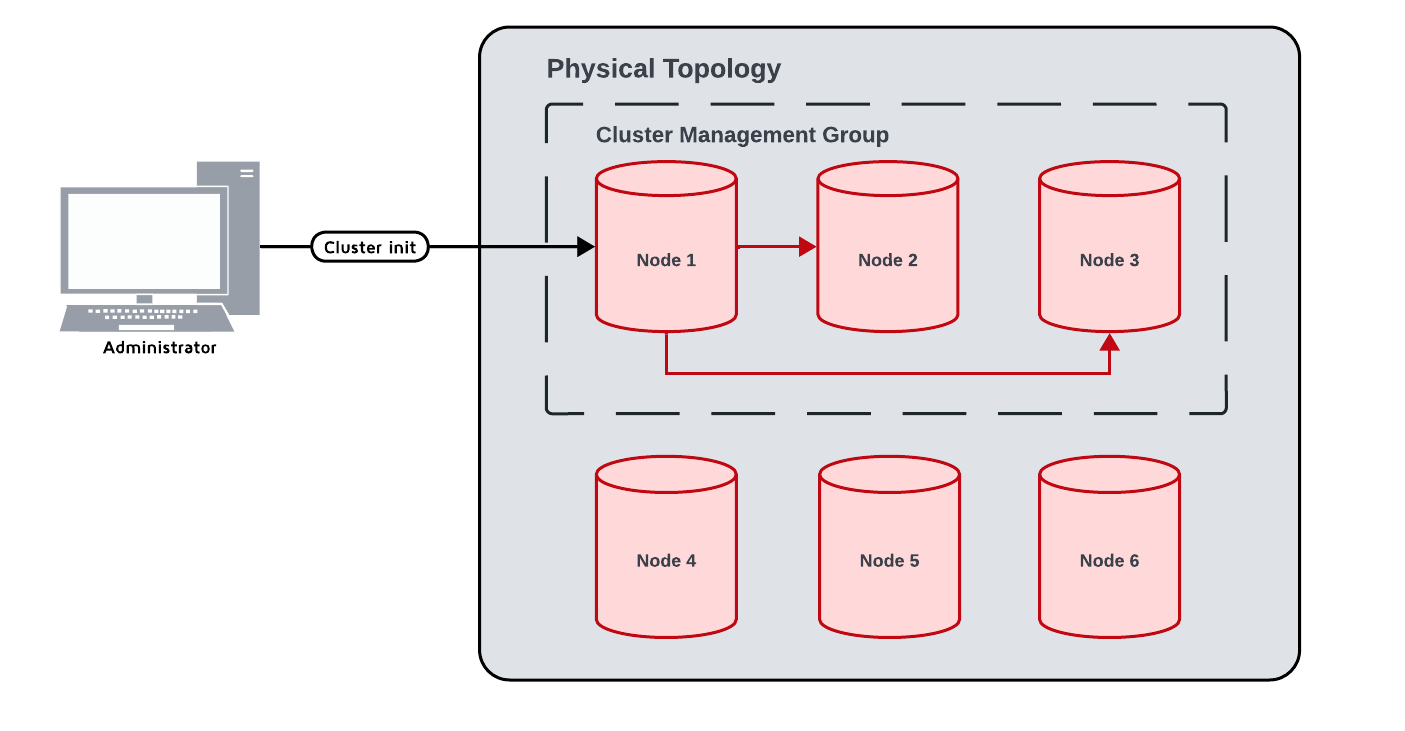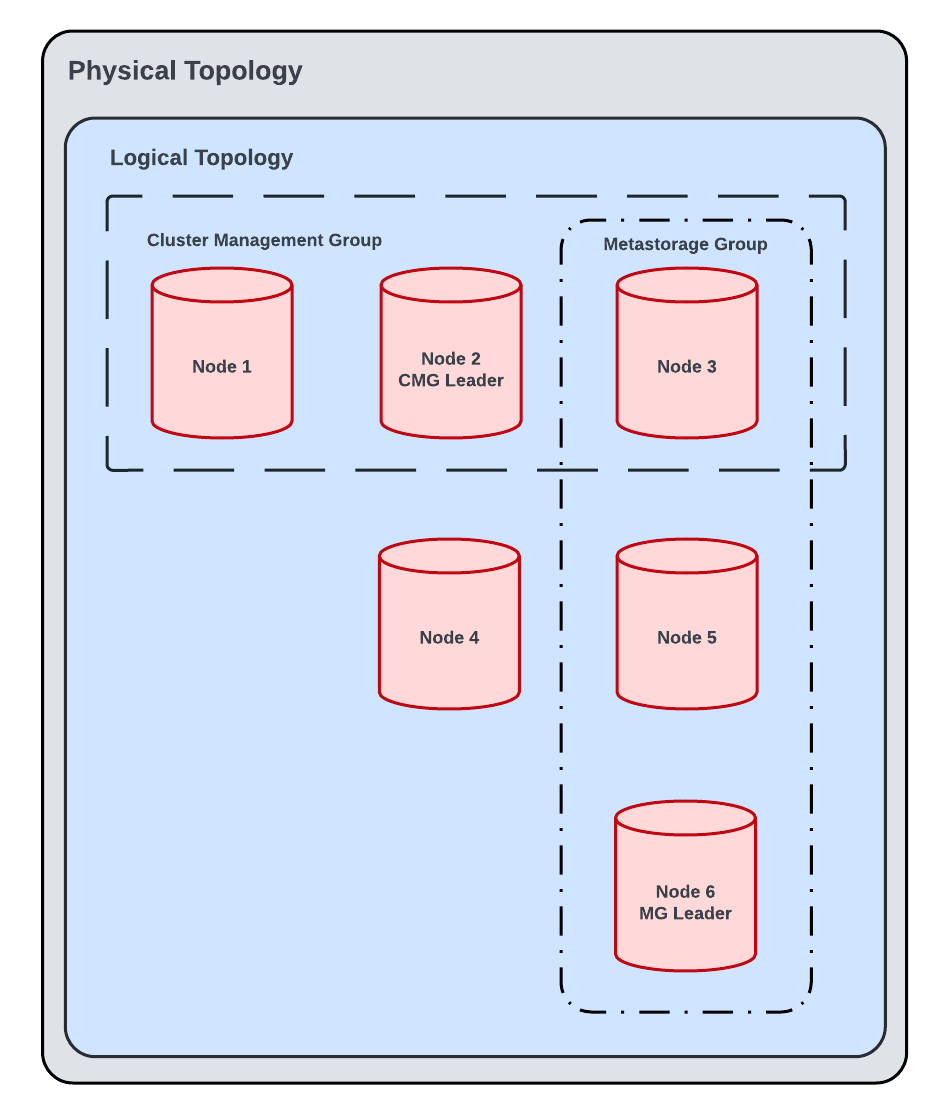Cluster Lifecycle
This topic covers the information covering GridGain 9 cluster initialization and lifecycle.
Node Start Without a Running Cluster
When nodes start, they check all addresses listed in the node finder configuration (network.nodeFinder).
All nodes found are added to the physical topology - the nodes that know each other. All nodes also share information about other nodes, so the topology will include all nodes whose address is listed in at least one other node. If there are nodes that are completely separated (for example, nodes A and B only know about each other, same with C and D), they will form separate physical topologies (in this example, you would have cluster with A and B, and another cluster with C and D).
If there is no running cluster, the nodes exchange information about the network, but do not start any processes until the cluster initialization command is received, nor do they form a logical topology - the nodes that are verified and form a cluster.
Node Requirements
All nodes in cluster must have similar time, that can be different by no more than schemaSync.maxClockSkewMillis. This is necessary for correct transaction operation.
As network latency can be unpredictable, some requests may take so long to arrive that the time will be different on the receiving node by the time request arrives. To account for the delay, set the schemaSync.delayDurationMillis property to the time that is long enough for the schema updates to be delivered to all nodes in the cluster. However, this delay also affects how long it takes for DDL to be executed, as all nodes need to wait for the delay to pass before applying the update.
Cluster Initialization
When the cluster init command is received by any node in the cluster, it starts the initialization process.
First, the nodes specified in the --cluster-management-group argument form a RAFT group and take on the role of the cluster management group (CMG) — a group responsible for managing cluster operations.

Next, the nodes specified in the --metastorage-group argument form a RAFT group and assume the role of the metastorage group. These nodes store the authoritative copy of the cluster’s metadata.
If only one of --cluster-management-group or --metastorage-group is specified, the specified value is used for both. If neither is specified, a set of nodes is automatically selected for both CMG and the metastorage group in alphabetical order. The number of selected nodes is determined as follows:
-
If the cluster size is 3 or fewer, all nodes are used for the metastorage group (CMG and metastorage).
-
If the cluster size is 4, three nodes are used to maintain an odd number, improving consensus efficiency.
-
If the cluster size is 5 or more, five nodes are used to balance fault tolerance and overhead.
Once the 2 raft groups are started and elect their leaders, all other nodes in the topology are notified that the cluster is started, and they can join it. At this point, the cluster is considered initialized and can start receiving requests.
Each non-leader node receives the invitation from the CMG to join the cluster and forms a validation request. Then, the request is sent to the CMG, and, after validation, the node receives cluster meta information from the metastorage group and joins the cluster.
The nodes are also added to the cluster logical topology - the nodes that are verified and accepted by CMG as part of the cluster. When nodes shut down or leave the physical topology for any other reason, the cluster logical topology is immediately adjusted.

Cluster Management Group
Cluster management group stores information about the cluster, the list of nodes that are in the cluster, and handles all cluster logical topology changes. Due to using RAFT consensus algorithm, the CMG improves the protection from split-brain (as any cluster group losing the CMG majority will no longer be fully functional).
It is recommended to have the CMG of 3, 5 or 7 nodes. For most clusters, going over 7 nodes in your CMG is not recommended. Larger management group improves stability, as it reduces the odds of losing the majority of CMG nodes, but may cause a minor performance hit.
Losing the majority of CMG nodes leaves the cluster mostly functional. The cluster without the CMG majority can still handle transactions and user requests, but cannot:
-
Add new nodes to logical topology.
-
Re-add nodes that left the cluster to logical topology.
-
Create new table indexes. In this scenario,
CREATE INDEXDDL operation will never be fully resolved and will hang the application.
To restore full cluster functionality, bring the offline members of CMG back online.
The CMG stores the following information:
-
Current cluster state, including what nodes are in CMG and metastorage groups, what GridGain version is used and cluster tag.
-
Consistent IDs of all nodes in the logical topology.
-
Node validation status.
By default, the information is stored in the work folder, but it can be configured on each CMG node by setting the ignite.system.cmgPath property.
Cluster Metastorage Group
Cluster metastorage group stores information about the data stored in the cluster, and handles data distribution.
It is recommended to have the metastorage of 3, 5 or 7 nodes. For most clusters, going over 7 nodes in your metastorage group is not recommended. Larger metastorage group improves stability, as it reduces the odds of losing the majority of metastorage nodes, but may cause a minor performance hit.
Losing the majority of metastorage nodes will turn the cluster inoperable and may lead to data loss.
The metastorage contains the following information:
-
Cluster catalog - the single storage of all meta information about the cluster - table schemas, indexes, views, distribution zone information, etc.
-
Logical topology history.
-
Other data required for cluster operation.
By default, the information is stored in the work folder, but it can be configured on each node by setting the ignite.system.metastoragePath property. In high load environments, it is recommended to have metastorage located on a separate hard drive, as high workload may cause slowdowns in partition allocation.
Old versions of data are kept in metastorage for 1 hour. GridGain checks every minute for expired metastorage data and removes it when it is no longer needed.
Node Join Scenarios
New Nodes Joining the Cluster
When a new node is started, it adds itself to the physical topology. Then, the CMG receives the event that a new node has joined the topology, and sends it an invitation to join the cluster. Once the node receives it, it sends the validation request with node information, which the CMG verifies and adds the node to the logical topology.
Node Rejoins the Cluster
If the node leaves the physical topology (for example, because the machine with the node is unreachable), the cluster logical topology is immediately adjusted, and the node is excluded from it. It can no longer rejoin the cluster with the same node ID.
To rejoin the cluster, the node must be restarted. During the restart, a new ID will be generated and the node will be able to join the physical and logical topology.
When a node reappears in the physical topology, the CMG sends it an invitation to join. The node then asks the CMG to validate itself, and, if this is successful, it starts its components (doing local recovery on the way), after which it tells the CMG that it’s ready to join. The CMG then adds it to the logical topology. This is the same process as the first join of a blank node.
Network Segmentation Scenario
If a cluster is partitioned at any point (for example, due to temporary network problems), only the part of the cluster that has the majority of both the cluster management and metastorage groups will continue to operate normally. If this happens, cluster topology will be automatically adjusted to exclude lost nodes, while other parts of the cluster will be inoperable. Nodes that are not part of either cluster management or metastorage group do not contribute to the majorities - only nodes that are part of those groups count.
The part of the cluster that does not have the management group majority, but has metastorage group majority will operate at a limited functionality. It would still be able to perform updates and read data, but not change its topology or create indexes.
The part of the cluster that lost metastorage group majority will be inoperable, even if it has management group majority.
If the cluster is split without a clear majority (for example, 4 cluster management group nodes were split evenly), both sides of the split will lose majority and have corresponding functional limitations.
When a cluster is split, data partitions might also be split. As GridGain creates a RAFT group for each partition, only the side that has the majority of partition replicas will be able to continue writing data. If a part of the cluster still maintains metastorage group majority and a majority for one or multiple partitions, it will be able to keep updating data in those partitions, but no other part of the cluster will be able to write conflicting data, thus avoiding potential split-brain scenario.
When disaster recovery is performed on a split cluster, it is important to identify potential sub-clusters that had data updates and recover data from them. If recovery is performed on a side that has the minority of partitions and the other side had data updates, it is possible to manually introduce split-brain.
When connectivity is restored, nodes will attempt to rejoin the cluster. The part of the cluster with the cluster management group majority can be used to restore the cluster without cluster-wide downtime. Nodes in other parts will need to be restarted to join the cluster as described above. Once cluster management group and metastorage group majority is restored on the physical topology, the cluster will restore full functionality. Any data updates from the sub-clusters will be automatically propagated to partition replicas that were not updated.
© 2025 GridGain Systems, Inc. All Rights Reserved. Privacy Policy | Legal Notices. GridGain® is a registered trademark of GridGain Systems, Inc.
Apache, Apache Ignite, the Apache feather and the Apache Ignite logo are either registered trademarks or trademarks of The Apache Software Foundation.
